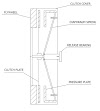SINGLE PLATE CLUTCH :-
Single Plate Clutch is widely used because of its ability to completely disengage the drive. It mainly consist of only one clutch plate. construction, working , advantages ,disadvantages ,applications of Single Plate Clutch are discuss below.
 |
FIG. A: SINGLE PLATE CLUTCH IN ENGAGE POSITION |
CONSTRUCTION OF SINGLE PLATE CLUTCH :-
- Single Plate Clutch mainly consist of clutch plate , pressure plate , flywheel , release bearing, clutch fork , etc.
- It consist of only one clutch plate. The clutch plate has internally splined hub. The internally splined clutch plate is mounted on externally splined clutch shaft.
- A pair of lining made of an asbestos based material is riveted to the both side of clutch plate. and clutch plate is sandwich between flywheel and pressure plate.
- The pressure plate is bolted to flywheel through thrust spring and flywheel is attached to engine crankshaft.
- An adjustable link is set to provide a small clearance between clutch fork and release bearing so that pedal has small amount of free movement.
- Spigot bearings are fitted at the center of flywheel so that clutch shaft can rotate smoothly.
- A pedal is provided to pull the pressure plate against the spring force whenever it is required to be disengaged.
WORKING OF SINGLE PLATE CLUTCH :-
- ENGAGE POSITION :- As shown in fig. A clutch is in engage position. The clutch plate is gripped between the flywheel and pressure plate with the help of thrust springs. Therefore there is friction between flywheel and clutch plate also in between clutch plate and pressure plate so that clutch plate revolves with flywheel .As clutch plate revolves internal splines of clutch plate locked with external splines of clutch shaft as a result clutch shaft start rotating and transmit the drive to remaining transmission train.
- DISENGAGE POSITION:-As shown in fig.B when pedal is pressed clutch fork push the pressure plate against the thrust spring so that pressure plate goes away from flywheel so that there is no friction between flywheel and clutch plate. This permits the clutch plate to run free and hence disengage the engine from transmission. As soon as the clutch pedal is pressed the clutch is said to be disengage otherwise it remains engage due to spring force.

FIG. B :SINGLE PLATE CLUTCH IN DISENGAGE POSITION
 |
FIG. B :SINGLE PLATE CLUTCH IN DISENGAGE POSITION |
ADVANTAGES OF SINGLE PLATE CLUTCH :-
- Single Plate Clutch is widely used because of its ability to completely disengage the drive.
- Single Plate Clutch is simple in construction.
- Single Plate Clutch is inexpensive and requires less maintenance.
- Single Plate Clutch is easy to operate because pedal movement is less.
- Less chances of failure.
DISADVANTAGES OF SINGLE PLATE CLUTCH :-
- Torque transmission capacity of Single Plate Clutch is less.
- Single Plate Clutch is less compact as compare to multi-plate clutch so that it is not used in small vehicles.
APPLICATION OF SINGLE PLATE CLUTCH :-
- Single Plate Clutch is used in Truck , Jeep, etc.
- Single Plate Clutch is used in Heavy Commercial vehicles.




0 Comments